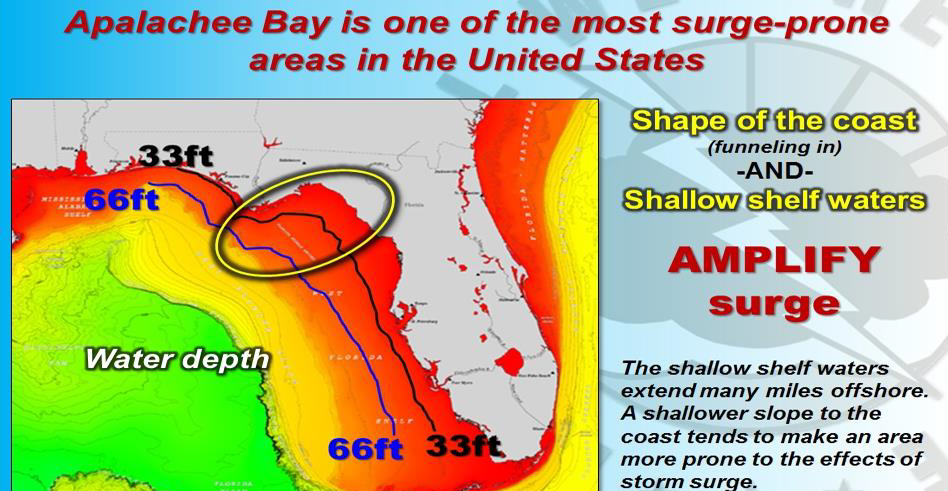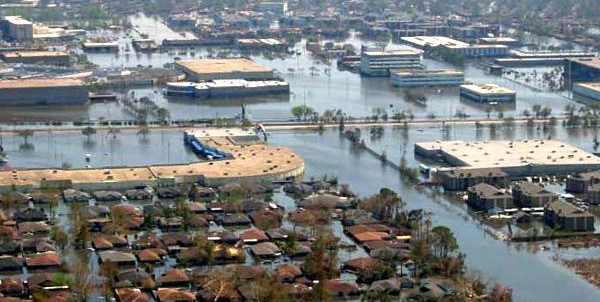What is Storm Surge?
Storm surge is the rise in sea water level that is generated by storms, hurricanes, cyclones, or typhoons. Storm surge becomes dangerous when the rising waters meet the coastline. This rise in water level can cause extreme flooding along miles of coastline, especially when storm surges exceed 20 feet or more above mean tide level. Depending on the size and strength of the storm surge, as well as ocean tide levels, flooding can last for several hours before water recedes after the storm passes.

Below are some definitions to help clarify storm surge terminology:
- Storm Surge: The abnormal rise of water generated by a storm, over and above the normal astronomical tide.
- Astronomical Tide: The tidal levels and water motion which result from the earth’s rotation and the gravitational effects of the earth, sun and moon.
- Storm Tide: The net effect of a storm surge and the astronomical tide. Not equivalent to the storm surge itself although the two are often confused.
- Inundation: The total water level that occurs on typically dry ground as a result of the storm tide. Conveyed using the metric of feet of water above ground level. Inundation is the most widely used method for communicating the damage of storm surge-riven coastal flooding.

Storm surge is one of the deadliest components of severe weather in America. About half of all U.S. deaths caused by tropical storms are due to storm surge. The combined effect of a storm surge flooding and sustained battering waves can cause extensive damage to buildings, infrastructure, and natural beachfront. Additionally, saltwater from the storm surge can get into freshwater lakes, rivers, and aquifers and make water supplies hazardous to drink, as well as endangering plants and wildlife.
Causes of Storm Surge
Storm surges are caused when water is pushed to the shore as a result of cyclonic winds. Winds cause the rise of a water “mound” at the center of the storm. Low pressure has a minimal effect in creating the storm surge mound in comparison with storm-driven winds on ocean waters.
Storms that are characterized as category 4 or 5 for their wind speed can produce a much larger mound effect than lower category storms. As a storm approaches the shore, water on the side facing the coastline further rises because it cannot dissipate into the open ocean.
The maximum level of storm surge for a particular area depends on a variety of factors including:
- Storm Intensity and Size: The size of a hurricane is often measured using the radius of maximum winds (RMW) metric which describes the distance from the center of a storm to its band of strongest winds.
- Angle of Approach: Hurricanes that approach the coast dead-on are more damaging; storms that travel at a parallel or oblique angle to the coast are less likely to cause a large storm surge.
- Central Pressure: Although pressure has a minor impact in comparison to wind, low air pressure can cause the severity of storm surge to increase by creating a slight increase in ocean levels at the center of the storm. About 5% of water rise is due to pressure.
- Coastal Shape and Characteristics: A larger storm is more likely to occur on coastlines that curve inward instead of outward. Bays and estuaries are especially vulnerable because the mound of storm water can get funnelled towards the shore. Areas where the seafloor is shallow are also more likely to be affected.
- Forward Speed: The speed of the storm can have varying impacts depending on the shape of the coastline that it is approaching. Fast moving storms are more damaging for straight coastlines and slow moving ones are more damaging for coastlines with bays and estuaries. The rate of movement of the eye of a hurricane is measured in miles per hour or knots.

How to Prepare for Storm Surge
Storm surges can approach communities near the coastline so quickly that residents do not have time to evacuate. The fast-moving waters can do significant damage to buildings and put lives in danger so it is important to have steps in place to protect your family and property.
Learning how to access and use a National Hurricane Center (NHC) National Storm Surge Hazard Maps can help you identify the risk of your area. These maps communicate how far above sea level a worst-case scenario storm surge will rise across a given area of coastland based on the intensity and direction of the storm. The NHC maps demonstrate how storm surge is not just a problem limited to immediate coastline areas; damage can affect miles inland from shore.
Before a storm surge threatens your area, find out whether you are in an evacuation zone. This is especially important if you live close to the coast. In an evacuation, follow evacuation orders from emergency officials to best protect yourself and your family members. Some other important steps to take if a storm surge is forecast are:
- Identify your emergency evacuation destinations, planning multiple routes if possible in case one escape is cut off
- Prepare an emergency kit; check on necessary supplies like medications, radios, flashlights, drinking water and batteries
- Close all basement windows if you have them
- Fuel your car; in the case of evacuation it might be difficult to stop for gas
If you are caught in a storm surge and not able to retreat to another area, here are some actions to take to protect yourself:
- Monitor the progress of the the storm and listen to any announcements from local officials
- Stay inside and protected from water if possible. It is best to stay on the downwind side of the house and away from windows
- Do not drive through flood waters. For more information on how to mitigate dangerous flooding damage to your home see our guide.
Historic Storm Surge Examples
Storm surge damage has been an important part of many notable weather events in U.S. history from the devastating 1900 Galveston, Texas hurricane to the long-lasting damage of hurricane Katrina. Below is a list of some of the most important historical instances of storm surge:
Galveston, Texas 1900
America’s deadliest weather disaster in history to date produced a storm surge of 15 feet. The category 4 hurricane claimed an estimated 6,000 to 12,000 lives in Galveston, Texas in 1900.
Kamille 1969
The storm surge from this hurricane reached 24 feet, the highest on record until Katrina. This hurricane is the record holder for the highest ever wind speed at an estimated 190 mph when it hit the Mississippi coast in 1969. However, the true extent of the storm’s power remains unknown because the hurricane destroyed all wind-recording instruments in the landfall area.
Katrina 2005
Hurricane Katrina was one of the most devastating and most costly natural events in U.S. history. Its catastrophic damage was worsened due to storm surge flooding of 25 to 28 feet above normal tide level along sections of the Mississippi coast and 10 to 20 feet above normal levels along the southeastern Louisiana coast. Gust wind speeds for the event reached as high as 87 mph. The storm caused severe breaches in the surge protection levees surrounding New Orleans which allowed surging storm waters to flood 80 percent of the city.

Ike 2008
Hurricane Ike did not have the category 3 or higher intensity of many other hurricanes on this list. However, at its landfall in Texas in 2008, the large size of the hurricane’s wind fields produced a 15 to 20 foot storm surge. The surge destroyed most of the structures on the Bolivar Peninsula of Texas.
Sandy 2012
Hurricane Sandy merged with a winter storm in 2012 and produced the largest diameter Atlantic hurricane on record, with winds covering 900 miles wide. The storm surge was particularly devastating in this case because it flooded tunnels, subways lines, and densely-built coastal areas in New York and New Jersey. Because of the location of the storm damage, the New York Stock exchange and Nasdaq were closed for two days and important train and air travel lines were severely disrupted.
Conclusion
Storm surge is undoubtedly one of the most dangerous components of severe weather in the U.S. A variety of complicated causes shape the intensity and danger of storm surges that result from storms. Therefore, checking your risk for flood and storm surge damage, especially if you live in a low-elevation coastal area, is an important step in protecting your home and family from extreme weather events.